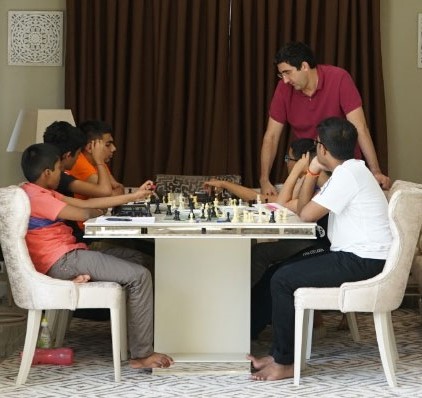


 Fittingly, Vladimir Kramnik starts the conversation talking about his approach to chess, heavily influenced by the fact that he had an artist and a music teacher as parents. The Russian goes even further and says:
Fittingly, Vladimir Kramnik starts the conversation talking about his approach to chess, heavily influenced by the fact that he had an artist and a music teacher as parents. The Russian goes even further and says:
I think most top players are artists in their own way, because I think you cannot really get into the very top just being a kind of point-making machine or money-cashing machine.
The conversation then goes into the subject of competitiveness, with Kramnik noting that he is not a particularly competitive person, as winning “is not a dominant motivation”. He acknowledges that most sportsmen do not share this perspective, and reminisces on the period in which he tried to be more competitive:
I even tried it myself, as an experiment, to be, you know, very result-oriented, even angry, very aggressive — but it never worked. I just understood it’s not [my style]. Usually when I play I’m just fully concentrated on the game, on the board. I never have anything against my opponent at all, not a single negative feeling. [...] Like Robert James Fischer’s famous sentence — I don’t know if it was very sincere or more for the public — that his biggest pleasure was to see his opponent’s ego getting demolished. For me that’s totally alien.
Kramnik is known for having changed styles frequently during his career, experimenting with different openings and approaches despite having to face the strongest players in the world. The former world champion explained with a smile:
Something switched in my mind. I mean, somebody, not really me, kind of switched the settings in my brain. [...] It’s not really that I planned it, or it was connected with a certain clear goal. I was lucky that this switch that happened at the end of the 1990s happened just before my match with Kasparov — that was luck, because it was exactly what I needed to play against Kasparov, it was excellent timing.
Undoubtedly, Kramnik’s most successful tournament was the Sparkassen Chess Meeting in Dortmund, an event he remarkably won ten times. Ganguly brought up the position he had against Nigel Short in 1995, the first time he won the event. Kramnik commented:
Somehow everything was going so smoothly in this event. Everything that I wanted was working. You know, these happy events in which, whatever you do, it works. And also Nigel Short was an extremely strong player at the time, and I beat him very easily and quickly, and it was quite surprising for me.
After going over another game from Dortmund, but from 2011, against Giri, Ganguly reminds Kramnik of a game he played against Ivan Sokolov in Wijk aan Zee 2005. The position was memorable for the host, because he was both at the venue and during the analysis session, when Kramnik declared that he had seen the eventual mating net that appeared on the board after 28.a4 in the following position:
White went on to use the open g-file to create a deadly attack against Black’s king. This sequence reminded Kramnik of a similar idea he used in a rapid game against Levon Aronian from 2015.
A discussion about endgames then began, with Kramnik explaining:
I liked endgames from the beginning. That was one of the reasons Botvinnik liked me a lot, because even at the age of 12 I always used the chance to go to an endgame. He was extremely happy when during one of the sessions I was showing some game — at that time I knew absolutely no theory since I never had a trainer — so I was always playing 1.e4 c5 2.f4 [...] and at some point I decided that after 2...d5 I can play 3.Bb5+ Bd7 4.Bxd7 Qxd7 5.d3 and 5...dxe4 6.dxe4 Qxd1 7.Kxd1. I showed the game where I won this endgame, and Botvinnik was so happy.
At the Qatar Masters 2014, ‘Big Vlad’ demonstrated how strong he had become in handling endgames since his childhood, in this case in a rook and knight endgame against Salem Saleh.
Of course, the former world champion also excelled in calculation and, to prove that he was still going strong even in the last years of his career, Ganguly set up the board with a position Kramnik had against Magnus Carlsen at the 2017 Norway Chess Tournament, when the Russian went for an astounding attack that started with a bishop sacrifice on h6.
Kramnik noted that this was the last decisive classical game against Carlsen, and said:
It was a memorable game. Actually it was the last decisive classical chess game between me and Magnus and it ended in my victory — it might not mean much, but still it’s nice (smiles).
It was a remarkably precise tactical sequence.
The amiable conversation continued, with Ganguly and Kramnik going over other greatest hits of the Russian’s career — and a couple of missed opportunities. Of course, they also remembered how ‘Big Vlad’ had wished for both Russia and India to win this year’s Online Olympiad, and how his wish had been granted!